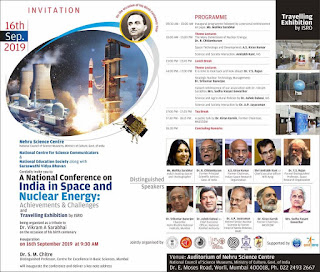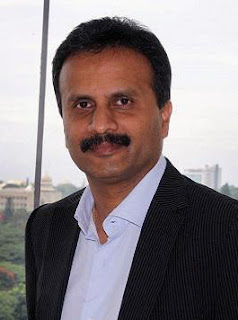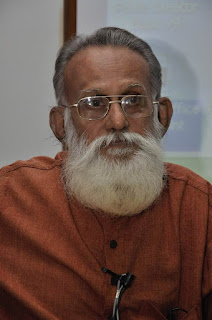Eulogy for Arun Jaitley: One Stop Trouble Shooter for BJP
The
24th, August 2019 @ 12.07PM, (IST) the date and time when the medical
bulletin from AIIMS announced the tragic news of passing away of Arun
Jaitley ji, will remain etched in my memory for an hitherto unknown
experience. On this day, for reasons I thought was due to the Jet Lag
that perhaps was not, I suddenly woke up at around 0300 hours local time
at hotel in Binghamton, New York, where I had travelled for an
official deputation with three of my NCSM colleagues. It was kind of a
very strange experience since I am one of those who are hardly affected
by a so called Jet Lag experience, when one travels to Europe and US.
But then I began to believe that age has caught up with me and with it
the Jet Lag. Since sleep eluded me completely- despite my best of
efforts - I tried catching up with my Sainik school and engineering
college friends on the whatsApp groups, which is the best of stress
buster that connects us all including our families.
There are few
hyperactive friends in these two groups who are always online for
chatting. When I logged on to the WhatsApp at around 0320 (Binghamton
time) I noticed that Shirish Patil from my SSBJ 77 group and Bhagavathi from the HKE group had posted an
important medical news bulletin from AIIMS in the group. It was the news
of the passing away of Arun Jaitley, who the press release said had
passed away @ 12.07 PM on the 24th August at the AIIMS where he was
admitted. Binghamton, US, is 9 hours 30 minutes behind the Indian Standard
Time, which meant that Arun Jaitley had passed away @ 0237 hours -
Binghamton local time - on the 24th, August, just 23 minutes before I
abruptly woke up. Was my untimely wake up kind of a premonition (sorry for being
unscientific) with the news of Jaitley ji death or was it because of the
natural biological Jet Lag phenomenon, I will leave the judgement to
the readers and not be judgemental on this premonition - unscientific
kind of an issue. I was one of those innumerable admirers of Jaitley and
his death did affect me. My Sainik school friend Mr Gurupad Hegadi, a die hard supporter of the BJP was an ardent fan of Arun Jaitley. Gurupad served as the Principal of the Delhi Kannada School, which is located on the Lodhi Road and this position Donne ted him with most of the politicians and other top Kannadigas in Delhi and he had met Jaitley with some of the MPs of Karnataka and often times he used to talk about him. Gurupad post his voluntary retirement moved to Karnatak but then we remain in touch. He had kind of an ordered me that I must write an eulogy for Jaitley if he is unable to combat his illness and departs for his heavenly abode. I sent a message to Gurupad to see if he is awake and has seen this news. He was awake and he was actually glued to the TV watching the news about Jaitley cremation. He reminded me once again that I must post an eulogy for Jaitley. But then when I reminded him that I am out of the country and that I will do the needful on my return to India, he was insistent and therefore I had no way but to write this eulogy to adhere to the request of my friend Gurupad, a die hard fan of Arun Jaitley.
Whatever little information that I
possess about Arun Jaitley, is based on the information that is
available on the public domain. But then one of my Sainik School
Bijapur friend, one year senior to me in school and an Ace Lawyer of national fame - Satish Maneshinde - enriched our knowledge about Jaitley’s unique attributes and
abilities, since Satish was friends with Arun Jaitley for more than three
decades. Jaitley was one stop solution veteran for most of BJP problems,
be it political (Rafale defence deal), economics (demonetisation and
GST) or what have you. He defended his government with all the erudition and legal brain that he possessed and it was very difficult for the most belligerent opponent to silence Jaitley neither on legal terms or on sound political arguments. Such has been the reputation of Arun Jaitley and his trouble shooting qualities for the government. It is also widely believed that Jaitley played a
pivotal role in Modi ji shifting from state politics to national
politics and the rest is history. Therefore it was no wonder that Modi
ji became emotional while addressing the Indian community in Bahrain
(where he was touring) when he received the news of the death of Jaitley, and described Jaitley as his very close friend
who was a political giant, towering intellectual and legal luminary and
an articulate leader who made a lasting contribution to India.
Jaitley ji was admitted to the AIIMS on the 9th of August, just three days
after the shocking death of his illustrious colleague Sushma Swaraj, for whom
Jaitley had paid obituary respects in his tweet on the 6th of August,
which unfortunately turned out to be the last but one tweet of Jaitley.
The absence or lack of clarity on the medical condition of Jaitley, which
AIIMS was releasing from time to time had created an apprehension that
he may not make it. Most unfortunately this worst fear came knocking at
Jaitley - the modern day Chanakya - to take him away to his heavenly
abode on the 24th August at 12.27 PM, just minutes after I woke up at
0300 hours, at Binghamton, USA. His par excellence intellect and his
outstanding articulations of BJP thoughts and ideologies - in which he
had firm conviction - both in and outside the Parliament, proved to be
the most effective combat for BJP to counter left and Congress leaning
intellectuals, whose acerbic criticism of the Modi led BJP made national
and international headlines, which often brought disrespect for the
party.
Jaitley was a god sent delight for any party to have as a
member and so it was with the BJP of which he was a member all
through his political career, starting with his association with the ABVP. His handling of the Party Spokesperson’s responsibilities and so also his innumerable other responsibilities that
the party bestowed him which kept him overly occupied with politics and
the looser was his judicial career in which he was truly outstanding. He continued to share and contribute
to his party’s interest till his very last breath. Even after he
prematurely withdrew from party affairs, due to his health conditions,
he continued to work for the party defending its decisions and
ideologies through his most well reasoned and intellectually enriching
blogs and cryptic, yet highly effective, tweets. His blog was delightful
reading, perhaps even for those who were in complete disagreement with
his points of view. There are very few, or may be none, in the BJP who
have this unique quality of intellectually taking on their adversaries
using the famed 'pen is mightier than the sword adage', which the left
intelligentsia and the Nehruvian congress party and the followers of
this ideology are famed not just in India but globally. Like most of
the left leaning intellectuals and Nehruvian socialites and
journalists, whose writings are normally picked up by most media both
nationally and internationally to form an opinion, Jaitley’s writings
too had this unique character. The past year or so has been a body blow
for BJP, which has lost four of their most outstanding leaders ; Atal
ji, Parrekar ji, Sushma ji and now Jaitley ji. It may take take a very
long time for the party to come to terms with such back to back shocks.
Arun Jaitley will be remembered for the GST, which he managed to
successfully pass through the parliament and while announcing the
benefits of GST he had said, in his inimitable erudition style, “the
old India was economically fragmented. The new India will create one
tax, one market and for one nation”. The GST, notwithstanding some of
the compulsive naysayers blaming it for the economic crisis in the
industry - Rahul Gandhi described GST as Gabbar Singh Tax, a metaphor
for terror tax -, was widely hailed as a game-changer for India's
economy. The International Monetary Fund had said it could eventually
add nearly two percentage points to India's growth. Although there have
been several initial hiccups and many businesses have struggled to adapt
to this new tax regime, yet the GST is on its path of taking firmer
roots and is destined to be remembered as a crowning glory and a true
legacy of Jaitley ji. Another major economic decision, the
demonetisation, which many considered to be an abrupt move of Prime
Minister Modi, which sent shock waves for the Indian economy, was also
bravely faced by Jaitley. He repeatedly defended the move as essential
to cracking down on tax evasion and promoting digital payments, calling
it a "watershed moment" that Indians would look back on with pride,
articulating his reasoning with fairly acceptable arguments.
A
lawyer by profession, Arun Jaitely was a key person in Prime Minister
Narendra Modi's Cabinet during his first tenure and almost always acted
as the chief trouble-shooter for the government. During the first five
years of the Modi government, Arun Jaitley shouldered several important
assignments including holding the portfolios of Finance Ministry,
Corporate Affairs Ministry, Defence Ministry, and Minister of
Information and Broadcasting at various times, including donning
multiple hats of different portfolios simultaneously. Arun Jaitley ji
was also the Indian Defence Minister besides he also held the Finance
and Corporate Affairs ministry. Although he never kept good health, he
was indispensable to Prime Minister Narendra Modi. Arun Jaitley had an
enviable contacts across the political, legal and social spectrum, which
he effectively used to support PM Modi, in the smooth passage of bills
in the Rajya Sabha, where the BJP was in a minority. He was the go-to
guy to keep the NDA running smoothly. He was Modi’s "eyes and ears".
Perhaps it was too much for Jaitley to continue to shoulder such arduous
responsibilities, while his health was failing him. Jaitley's
deteriorating health including his kidney transplant in May 2018,
compelled him to opt out of Modi's second government and active
electoral politics but then before he could recuperate destiny had a
different role set out for him in the heavenly abode where he now
resides in eternal peace.
Leaders cutting across party lines
were united in overwhelmingly paying extraordinary rich tributes to Arun
Jaitley ji. Arun was one of those young student leaders who was jailed
for taking part in student protests during the emergency period. He will
be remembered for taking on the - hit and run striking man - Arvind
Kejriwal, who has a compulsive allegation habit, which he used most
effectively to make corruption and other allegations against all and
sundry including Arun Jaitley. But then Kejriwal had to bite the dust
and render an unconditional apology to Jaitley, who sued him for
character assassination and false allegations. Not withstanding the fact
that Kejriwal had hired - the one and only - Ram Jethmalani to defend
him, yet Kejriwal had to accept defeat and render an unconditional
apology and withdraw his false allegations. Such was the strength and
power of conviction that Jaitley ji had in his integrity.
Now
that Arun Jaitley is gone for his heavenly abode, yet one thing remains
certain, his voice will continue to reverberate not just in the
Parliament but all across India. Long live Jaitley ji. RIP.







































